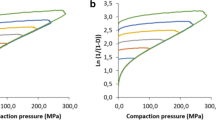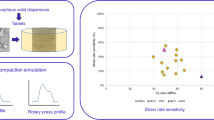ABSTRACT
Purpose
To evaluate the effect of tablet compression on the physical stability of amorphous indomethacin.
Methods
The amorphous indomethacin generated by melt cooling, rapid (5°C/min) or slow (0.2°C/min) cooling, was evaluated by PXRD, mDSC and FTIR analysis. Non-isothermal crystallisation behaviour was assessed using mDSC and any structural changes with compression were monitored by FTIR. Amorphous indomethacin was compressed in a DSC pan using a custom made die cavity-punch setup and further analysed in the primary container to minimize stress due to sample transfer and preparation.
Results
Compression of amorphous indomethacin induced and increased the extent of crystallisation upon heating. DSC results revealed that amorphous indomethacin generated by rapid cooling is more prone to compression induced crystallisation than the slowly cooled one. Onset temperature for crystallisation (T c ) of uncompressed slowly and rapidly cooled samples are 121.4 and 124°C and after compression T c decreased to ca 109 and ca 113°C, respectively. Compression of non-aged samples led to higher extent of crystallisation predominantly into γ-form. Aging followed by compression led to crystallisation of mainly the α-form.
Conclusions
Compression affects the physical stability of amorphous indomethacin. Structural changes originated from tablet compression should be duly investigated for the stable amorphous formulation development.







Similar content being viewed by others
Abbreviations
- DT:
-
dwell time
- FTIR (ATR):
-
Fourier transform infrared spectroscopy (Attenuated total reflectance)
- m:
-
minute
- mDSC:
-
modulated differential scanning calorimetry
- PMMA:
-
poly(methyl methacrylate)
- PXRD:
-
powder x-ray diffraction
- T c :
-
onset temperature for crystallisation
- T g :
-
glass transition temperature
- TSDC:
-
thermally stimulated depolarization current spectroscopy
- ΔC p :
-
heat capacity change
- ΔH c :
-
heat of crystallization
- ΔH f (α) :
-
melting enthalpy of α-form
- ΔH f (γ) :
-
melting enthalpy of γ-form
- ΔH rec :
-
enthalpy recovery
REFERENCES
Hancock BC, Parks M. What is the true solubility advantage for amorphous pharmaceuticals? Pharm Res. 2000;17(4):397–404.
Okumura T, Ishida M, Takayama K, Otsuka M. Polymorphic transformation of indomethacin under high pressures. J Pharm Sci. 2006;95(3):689–700.
Yoshioka M, Hancock BC, Zografi G. Crystallization of indomethacin from the amorphous state below and above its glass transition temperature. J Pharm Sci. 1994;83(12):1700–5.
Carpentier L, Decressain R, Desprez S, Descamps M. Dynamics of the amorphous and crystalline α-, γ-phases of indomethacin. J Phys Chem B. 2006;110(1):457–64.
Vyazovkin S, Dranca I. Effect of physical aging on nucleation of amorphous indomethacin. J Phys Chem B. 2007;111(25):7283–7.
Bhugra C, Shmeis R, Pikal MJ. Role of mechanical stress in crystallization and relaxation behavior of amorphous indomethacin. J Pharm Sci. 2008;97(10):4446–58.
Andronis V, Yoshioka M, Zografi G. Effects of sorbed water on the crystallization of indomethacin from the amorphous state. J Pharm Sci. 1997;86(3):346–51.
Desprez S, Descamps M. Transformations of glassy indomethacin induced by ball-milling. J Non-Cryst Solids. 2006;352(42–49):4480–5.
Karmwar P, Graeser K, Gordon KC, Strachan CJ, Rades T. Effect of different preparation methods on the dissolution behaviour of amorphous indomethacin. Eur J Pharm Biopharm. 2012;80(2):459–64.
Van Den Mooter G, Craig DQM, Royall PG. Characterization of amorphous ketoconazole using modulated temperature differential scanning calorimetry. J Pharm Sci. 2001;90(8):996–1003.
Forster A, Hempenstall J, Rades T. Investigation of drug/polymer interaction in glass solutions prepared by melt extrusion. Int J Vib Spec. 2001;5(6): http://www.ijvs.com/volume5/edition2/section3.html accessed on May 4, 2012.
Capaldi FM, Boyce MC, Rutledge GC. Enhanced mobility accompanies the active deformation of a glassy amorphous polymer. Phys Rev Lett. 2002;89(17):175505 (1–4).
Ayenew Z, Paudel A, Van den Mooter G. Can compression induce demixing in amorphous solid dispersions? A case study of naproxen-PVP K25. Eur J Pharm Biopharm. 2012;81(1):207–13.
Daver F, Blake A, Cakmak M. Stages of structural ordering leading to stress induced crystallization of PEEK films: a mechano-optical study on deformation, relaxation and retraction. Macromolecules. 2009;42(7):2626–33.
Lee HN, Riggleman RA, de Pablo JJ, Ediger M. Deformation-induced mobility in polymer glasses during multistep creep experiments and simulations. Macromolecules. 2009;42(12):4328–36.
Lee H, Ediger MD. Interaction between physical aging, deformation, and segmental mobility in poly(methyl methacrylate) glasses. J Chem Phys. 2010;133(014901):1–9.
Imamura K, Kagotani R, Nomura M, Tanaka K, Kinugawa K, Nakanishi K. Influence of compression on water sorption, glass transition, and enthalpy relaxation behavior of freeze-dried amorphous sugar matrices. Int J Pharm. 2011;408(1–2):76–83.
Baird JA, Van Eerdenbrugh B, Taylor LS. A classification system to assess the crystallization tendency of organic molecules from undercooled melts. J Pharm Sci. 2010;99(9):3787–806.
Fukuoka E, Makita M, Yamamura S. Some physicochemical properties of glassy indomethacin. Chem Pharm Bull. 1986;34(10):4314–21.
Karmwar P, Boetker JP, Graeser KA, Strachan CJ, Rantanen J, Rades T. Investigations on the effect of different cooling rates on the stability of amorphous indomethacin. Eur J Pharm Sci. 2011;44(3):341–50.
Wojnarowska Z, Adrjanowicz K, Wlodarczyk P, Kaminska E, Kaminski K, Grzybowska K, et al. Broadband dielectric relaxation study at ambient and elevated pressure of molecular dynamics of pharmaceutical: indomethacin. J Phys Chem B. 2009;113(37):12536–45.
Andronis V, Zografi G. Crystal nucleation and growth of indomethacin polymorphs from the amorphous state. J Non-Cryst Solids. 2000;271(3):236–48.
ACKNOWLEDGMENTS AND DISCLOSURES
ZA is grateful for the financial support of IRO, KU Leuven. AP also acknowledges D.B.O.F., KU Leuven, for providing a PhD grant. Department of Metallurgy and Materials Engineering (MTM), KU Leuven is also greatly acknowledged for providing facility for the ATR-FTIR.
Author information
Authors and Affiliations
Corresponding author
Rights and permissions
About this article
Cite this article
Ayenew, Z., Paudel, A., Rombaut, P. et al. Effect of Compression on Non-isothermal Crystallization Behaviour of Amorphous Indomethacin. Pharm Res 29, 2489–2498 (2012). https://doi.org/10.1007/s11095-012-0778-5
Received:
Accepted:
Published:
Issue Date:
DOI: https://doi.org/10.1007/s11095-012-0778-5




